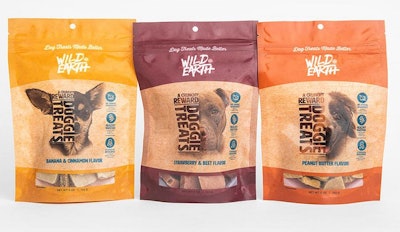
Proteins from sources other than animals have received a healthy dose of attention for both pet food and human food in recent years, attracting not only consumer interest but also heavy investment. Cue the latest announcement: Mark Cuban, entrepreneur and “Shark Tank” judge, recently helped Wild Earth, which since 2019 has offered dog treats and foods derived from cultured koji, a fungus, secure US$23 million in additional funding to develop pet foods with other cell-based proteins. (Cuban was also an initial investor in the company in 2019.)
While Wild Earth is not as well known as human-food alternative food brands like Impossible Foods and Beyond Meat, its executives are no doubt thrilled with that level of interest, not to mention the funding. Yet that might be just a drop in the bucket of the overall investment rush in this area, especially for human food. Invested capital in alternative proteins overall reached US$3.1 billion in 2020 alone, compared to US$5.9 billion for the previous 10 years combined. The 2020 figure represented a tripling of growth in just one year.
Why all the hype, with money following on its heels? The world’s population continues to grow, particularly in regions like Africa and Asia, also pushing the demand for protein, particularly meat. As with many areas, pets track closely behind in terms of rising populations (further spurred by the pandemic) and protein intake. At the same time, animal protein production tends to be resource intensive, far outpacing that needed to produce proteins from plants, insects and other sources, according to some data.
As consumers increasingly focus on sustainability and use of natural resources, connecting it to what they eat and even to what their pets eat, they are open to alternatives to animal-based proteins. And where the almighty consumer dollar goes, so go dollars from other entities. Even traditional meat-based companies like Tyson and Cargill are getting in on the act.
Rapidly growing market with high investment
The alternative protein investment data cited above came from the Good Food Institute and was shared by Susanne Wiegel, Ph.D., investment manager for alternative proteins for food with Nutreco NuFrontiers, as part of her Petfood Forum 2021 presentation on innovation and alternative pet food proteins. (Due to COVID-related travel restrictions for Wiegel, her colleague Trevor Faber, Ph.D., director of companion animal nutrition and technical service for Trouw Nutrition, a subsidiary of Nutreco, will deliver the presentation on September 23 in Kansas City.)
To further illustrate the growth in the alternative protein market, Wiegel also shared “maps” from 2018 and 2021 to date compiled by NewProtein.org (formerly NewMeat.org). The 2018 map showed about six dozen logos of companies involved in the market—compared to several hundred logos on the 2021 map. And, that map has subsequent pages breaking out alternative proteins into categories such as plant based and cell-based.
Of the US$3.1 billion in investment capital in alternative proteins in 2020, most lay in plant-based proteins, at US$2.1 billion. Yet two other categories, fermentation and cultivated, are catching up, at US$590 million and US$360 million, respectively. The figure for cultivated proteins represented growth of six times the previous year’s investment. A perhaps more recognizable name in the cultivation protein category is Memphis Meats, which attracted US$186 million in investment, the largest funding round for that category in 2020.
The future is in the lab?
Wiegel and Nutreco seem particularly bullish on cell-based, or cultivated proteins, because for human food, they promise to “overcome taste limitations while alleviating consumer concerns,” she said. “As with all food trends, this will impact pet food, and we are seeing the first companies engaging with the sector.”
That includes Wild Earth, which technically uses plant-based proteins now, but intends to use its new funding to “develop cell-based chicken, beef and seafood from its proprietary technology in order to provide a wide variety of products on the market,” according to an article by Maxwell Rabb on TheBeet.com.
Other players include Because, Animals, which has created a cat treat made from cultured mouse cells and won innovation competitions such as Purina’s Pet Care Innovation Prize. Similarly, Bond Pet Foods, which has produced a dog treat bar using cultured protein from chicken cells, was a finalist in Nutreco’s Food Tech Finals (among other achievements), and Blue Nalu, a “think tank exploring aquaculture opportunities for highly nutritious pet food,” was one of five winning 2020 Nestle Purina PetCare Accelerators.
Wiegel emphasized that these companies, along with all the ones in the human food space, are in the early stages of developing their technologies and face numerous challenges on the path to commercialization, including regulatory approval and scaling up while bringing costs and prices down. Yet, “cell-cultured proteins will be a reality soon and a high-growth opportunity,” she said.
LinkedIn

















